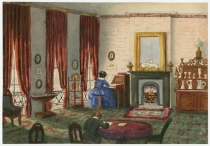Titled “Our Room” in German, this small watercolor captures a rare snapshot of daily home life in the 1850s French Quarter. The address is today on the 300 block of Dauphine Street, between Bienville and Conti Streets. The language used for the title suggests that the artist may have been one of the many German immigrants to New Orleans in the nineteenth century. His title and cozy domestic subject hint at love and pride for the home his family has built here.
I love using this image in my lectures about decorative arts history because it highlights so many key trends in 1850s material culture. As residences grew larger and industrial advances made possible the mass production of furniture and textiles, more middle-class Americans could afford to set aside a room in their homes as a formal parlor. Families would gather there for entertaining and leisure. With one of the new upright piano models, ladies of the house could offer genteel entertainment with songs and dances.
Almost every object in this room exemplifies its era. The patterned wallpapers, woven carpet, and mantel Argand lamps all resulted from new manufacturing techniques. Large mirrors made rooms feel larger. The display cabinet, or étagère, on the far right was perhaps the epitome of parlor luxury. Valuable more for its stylish form than its storage function, it devoted a great deal of space to showcasing just a few pieces of glass and china.

